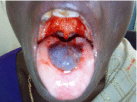
Case Report
Austin J Otolaryngol. 2021; 8(1): 1121.
Lingual Hematoma: A Rare Presentation
Bhandary R and Poojitha S*
Deptartment of Otorhinolaryngology, A J Institute of Medical Sciences, India
*Corresponding author: S Poojitha, Post-graduate, Department of Otorhinolaryngology, A J Institute of Medical Sciences, Mangalore, India
Received: May 01, 2021; Accepted: May 31, 2021; Published: June 07, 2021
Abstract
Lingual hematoma is a rare cause of airway compromise and is usually seen secondary to use of anticoagulants, which exerts effects on coagulation cascade, and also causes thrombocytopenia. The patient in this case report presents with a lingual hematoma which is not related to the use of any anticoagulants. Luckily, the hematoma did not enlarge enough to cause obstruction of airway requiring tracheotomy. However, the cause of the hematoma is deduced to be due to husk - injuring the tongue mucosa. This case is unique in its rare presentation as well as the cause for the hematoma in our report has never been reported in literature.
Keywords: Lingual hematoma; Anticoagulants; Airway obstruction; Traumatic
Case Presentation
A 38 year old lady presented to our tertiary care hospital with a history of rapid enlargement of a painless swelling over the tongue, acute in onset, progressed within a matter of a few hours. She gave history of ingestion of beaten rice for breakfast following which she noticed the swelling. There was no history of any prior medication, especially anticoagulants. On examination, a 4x3 cm ovoid swelling was noted over the dorsum of tongue, just anterior to the circumvallate papillae (Figure 1). On indirect laryngoscopy, there was no other abnormality over the base of tongue or in the endolarynx. There was no airway compromise; however there was a muffled voice owing to articulatory difficulty and mild dysphagia.

Figure 1: Lingual hematoma following a husk injury.
The patient was admitted to our hospital and observed in view of further increase in the size of the swelling. The patient was treated conservatively with intravenous antibiotics and anti-inflammatory drugs, and improved drastically. The next day, the swelling had regressed in its size (Figure 2). She had improved symptomatically and regained her normal voice and swallowing. She was discharged on oral antibiotics, and when she came for review after 1 week the swelling had completely disappeared.

Figure 2: Lingual hematoma which has partially resolved.
Discussion
Acute enlargement of the tongue is rare but a recognised airway hazard that has been classified by Renehan and Morton [1]. Categories include haematoma resulting from trauma, vascular anomalies or coagulopathy; and also oedema, infarction and infection. Trauma caused by road traffic accident [2,3], dental surgery [4] and tongue biting in seizure [5] have been described. Warfarin appears in several cases as a factor in spontaneous lingual haematoma [6]; additionally streptokinase [7] and haemophilia [8] have been implicated in isolated reports. Penetrating injuries to tongue mucosa carry a risk of lingual swelling and hematoma formation which may result in airway compromise. Progressive lingual and sublingual swelling displaces the tongue posteriorly and cephalad eventually producing dysphonia, drooling of saliva, dyspnea and finally stridor, heralding upper airway obstruction. A minority of cases in the literature have indicated a causative factor for sublingual hematoma arising from trauma alone without any anticoagulation significance, such as after oral surgical procedures. It is also worth acknowledging the necessity of surgical drainage versus non-surgical intervention as in the case of the sublingual hematoma. The majority of previously described cases have found spontaneous resolution of the hematoma once coagulation is normalized [9].
In conclusion, lingual hematomas can quickly develop into a life threatening condition, and early recognition, prompt medical treatment and continuous clinical monitoring are necessary to prevent the need for a surgical airway procedure.
References
- Renehan A, Morton M. Acute enlargement of the tongue. British Journal of Oral and Maxillofacial Surgery. 1993; 31: 321-324.
- Hing N, Bowler M, Byth P, Daly C. Lingual haematoma leading to upper airway obstruction. British Journal of Oral and Maxillofacial Surgery. 1985; 23: 322-325.
- Chase C, Hebert J, Farnham J. Post-traumatic Upper Airway Obstruction Secondary to a Lingual Artery Hematoma. The Journal of Trauma: Injury, Infection, and Critical Care. 1987; 27: 953-954.
- Kaftan B, Snyder H. Lingual artery hematoma resulting in upper airway obstruction. The Journal of Emergency Medicine. 1991; 9: 421-424.
- Saah D, Braverman I, Elidan J, Nageris B. Traumatic Macroglossia. Annals of Otology, Rhinology & Laryngology. 1993; 102: 729-730.
- Cohen A, Warman S. Upper Airway Obstruction Secondary to Warfarin- Induced Sublingual Hematoma. Archives of Otolaryngology - Head and Neck Surgery. 1989; 115: 718-720.
- Williams P, Jani P, McGlashan J. Lingual haematoma following treatment with streptokinase and heparin; anaesthetic management. Anaesthesia. 2007; 49: 417-418.
- Takeuchi M, Shikimori M, Kaneda T. Life-threatening sublingual hematoma in a severely hemophilic patient with factor VIII inhibitor. Journal of Oral and Maxillofacial Surgery. 1986; 44: 401-403.
- Pigadas N, Simoes P, Tuffin J. Massive sublingual haematoma following osseo-integrated implant placement in the anterior mandible. British Dental Journal. 2009; 206: 67-68.